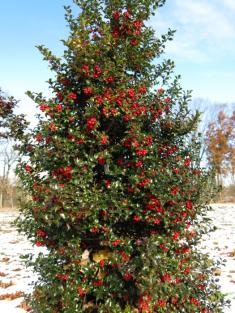- Agricultural Products
-
Holly
Holly: Red Beauty®
Overview

Variety: Red Beauty®
Principal Investigators: Elwin Ortin, David Gant, Constance Gant
Strengths & Qualities
- Proven to be highly deer resistant
- Hardy enough to cope with typical east coast conditions
- Beautiful, shiny, dark green foliage which hold its color well throughout the winter
- Has abundant bunches of good sized, bright red berries which are well displayed and not hidden among the leaves
- Has an elegant, pyramidal shape
- Is compact growing (in scale with even smaller gardens)
- Does not suffer from any major pests and diseases
- Requires minimal maintenance
- Needs pollinator for good berry production, such as 'Blue Prince'
- Moderate-to-slow growth. Reaches 9 feet tall, 4-5 feet wide in 10 years. May reach 12 feet in 25 years.
- Besides providing boughs for decking the halls, American hollies are wildlife friendly. In May and June, bees work the blossoms and in late winter, robins, cedar waxwings, wild turkey and 15 other bird species eat the fruit, often in a feeding frenzy.
History
- The coastal holly forests of colonial New Jersey were liberally harvested in a cottage industry that served the New York markets and it wasn’t long before native stands were at risk. By the 1920’s, native holly stands had been decimated through much of its North American growing range.
- Clarence Wolf, owner of the New Jersey Silica Sand Company in Millville, had been sending holly cuttings to clients and friends since 1926. When wild stocks began to peter out, he planted a 55-acre holly orchard with some 41,000 trees, mostly transplanted from local swamps and forests. The tender holly buds were often protected from frost with bonfires and later with wind machines imported from California. The wind machines were like those used in orange groves and circulated warm air with cooler air kept below the trees, keeping the tender holly buds from freezing.
- Dan Fenton took over the Holly Farm and, in 1947, helped form the Holly Society of America in Millville (officially, “Holly City”) with Wolf and Elizabeth White, a woman otherwise known for introducing the nation’s first cultivated blueberry. Cuttings from the Wolf and White holly collections were planted at the Rutgers Gardens in East Brunswick.
- In the 1960s, Dr. Elwin Orton arrived on campus and set about breeding holly. His first introduction in the 1970s, Jersey Princess, was an upright, conical tree bred for darker leaf color and heavy berry set. Following it were Dan Fenton, Jersey Knight, and a series of dwarf clones named Jersey Jewel, Jersey Midget, and Jersey Sprite.
- After 22 dedicated years of hybridizing and testing, Rutgers’ Red Beauty® holly was developed from three species (ilex aquifolium, ilex rugosa and ilex pernyi) which distinguishes it from all other forms of Ilex.
Intellectual Property
- US Plant Patent No. PP14,750 issued May 4, 2004
- Ilex interspecific hybrid named ‘Rutzan'
Contact Us
Contact: Christine Chow
